Barnard 150 - The Seahorse Nebula(18.3 hours in LRGB) - Using the Wrong Tool For the Job!
Date: Oct 3, 2025
Cosgrove’s Cosmos Catalog ➤#0151
Table of Contents Show (Click on lines to navigate)
About the Target
Overview
Barnard 150 (the Seahorse Nebula) appears as a twisting dark cloud silhouetted against a dense field of Milky Way stars.
Barnard 150 (B150), also known as the Seahorse Nebula, is a prominent dark nebula in the northern constellation Cepheus.
It is essentially a dense molecular cloud of interstellar dust so thick that it absorbs the light of the stars behind it, making the nebula visible as a dark silhouette against the bright star fields of the Milky Way. Spanning roughly 1° of the sky (about two full-moon widths), this elongated, sinuous cloud has an S-shaped profile that inspired its nickname, the seahorse.
Barnard 150 lies roughly 1,200 light-years from Earth (estimates in the literature range ~880–1,200 ly).
Unlike a glowing emission nebula, the Seahorse Nebula does not emit notable visible light of its own – it stands out only by the absence of starlight, carved into the sky by its light-blocking dust.
Discovery and Designations
E. E. Barnard
Barnard 150 was first cataloged in the early 20th century by the American astronomer Edward Emerson Barnard, a pioneer of wide-field astrophotography. In 1919, Barnard published a list of 182 “dark markings of the sky,” recognizing that certain starless patches were actually opaque nebulae of gas and dust. He listed this object as Barnard 150, describing it as a “curved dark marking, 1° long”.
Barnard’s work was groundbreaking – he demonstrated that these dark voids were not empty space but rather interstellar clouds blocking the background stars. In 1962, astronomer Beverly Lynds included the same object in her Catalogue of Dark Nebulae, assigning it the designation Lynds Dark Nebula 1082 (LDN 1082). Barnard 150 is now commonly referred to as the Seahorse Nebula (or “Dark Seahorse”) due to its shape. It has also appeared under the label GF 9 (from Schneider & Elmegreen (1979), A catalog of dark globular filaments) in some scientific literature, from a 1970s catalog of “globular filament” dark clouds. These various names all correspond to the same object – a striking dark nebula in Cepheus.
Location and Context
The Seahorse Nebula is situated in the northern Milky Way, within the constellation Cepheus (not far from Cassiopeia and the north celestial pole). This region of the sky harbors many dusty clouds and young stars, sometimes called the Cepheus Flare region – a large complex of interstellar clouds in which Barnard 150 is a part.
In the sky, B150 lies roughly between the faint Flying Bat Nebula (Sharpless 2-129, an emission nebula) and the Fireworks Galaxy (NGC 6946). The dark nebula’s apparent size on the sky is about 1°, which corresponds to a physical span on the order of 15–20 light-years across. In other words, Barnard 150 is a sizable cloud of gas and dust, large enough to stretch about 20 light-years end-to-end. Despite its considerable size, it has no sharp boundaries – the cloud’s edges gradually blend into the surrounding star field, and its shape appears irregular and “silhouette-like” against the Milky Way.
Physical Characteristics and Star Formation
Barnard 150 is a cold, opaque molecular cloud composed of cosmic dust grains and hydrogen gas. The dust is what makes the nebula dark: it scatters and absorbs visible light extremely effectively, obscuring the star glow behind the cloud. The nebula’s shape is filamentary and somewhat serpentine, with convoluted twists rather than a simple, uniform outline. Within this dark cloud, astronomers have identified three especially dense clumps of material, labeled LDN 1082 A, B, and C, which serve as small stellar nurseries embedded within the nebula. In fact, the inner regions of Barnard 150 are actively forming stars: faint, low-mass protostars have been detected within these cores .
Showing locations of LDN 1082 A, B, and C.
These nascent stars are extremely young – classified as Class 0 young stellar objects – and they remain invisible in ordinary optical telescopes because the surrounding dust cocoons them completely. Only observations in long-wavelength light (such as infrared and millimeter radio waves) can penetrate the dust to reveal these newborn stars. The presence of these hidden protostars confirms that Barnard 150 is not just a random cloud of dust, but an active star-forming region. It is essentially a stellar nursery in its earliest stages, where clusters of low-mass stars are gradually forming within the dark nebulosity.
Scientific Research
As an accessible example of an isolated dark nebula, Barnard 150 has been the subject of research to understand the process of star formation in such clouds. Astronomers have studied its structure, composition, and internal conditions using a variety of methods. For example, measurements of Barnard 150’s densest core (often referred to in studies as part of the “GF 9” filament) have examined the cloud’s magnetic field. Notably, a 2018 study found the magnetic field across one of the Barnard 150 cores (L1082C) to be remarkably uniform, suggesting that magnetic forces might be influencing how the core holds its shape and collapses to form stars. By mapping dust polarization and gas motions, researchers can infer how magnetism and turbulence inside the cloud affect star formation. Observations at infrared and radio wavelengths (using space telescopes and ground-based radio observatories) are especially valuable for Barnard 150, since these penetrate the dust and unveil details invisible in optical light – such as the embedded protostars, outflows from young stars, and the cloud’s temperature and density structure. Insights gained from studying Barnard 150 contribute to our broader understanding of how low-mass stars form out of the cold, dark interstellar medium. Each dark nebula like this serves as a natural laboratory for astronomers to test theories of star birth and to observe the very earliest phases of stellar evolution in our galaxy.
The Annotated Image
Created with ImageSolver and FinderChart scripts in PixInsight.
The Location in the Sky
This annotated image created with Imagesolver and FInderChart Scripts in Pixinsight.
About the Project
Picking the Target
In preparation for the past imaging cycle, I noted that Cepheus was well-positioned, and I began searching for objects in this region that I had not previously photographed. I came across Barnard 150 and recognized it as a well-known Dark nebula. This year, for the first time, I have been choosing dark nebulae as targets, so I was open to targeting this one.
I still needed a target for my Astro-Physics 130mm platform, so I decided to shoot it there. In some ways, this was not ideal. B150 is quite large, and the AP130 has a narrower field of view. It is also an f/8.35 system. Not ideal for Dark nebulae with no bright component, but I decided to give it a go.
I would shoot 90-second subs in LRGB. I would shoot two Lum Filter exposures for each RGB filter exposure so that I could maximize my capture for this dark target.
Data Collection
The weather cooperated on August 22, 24, 30, and 31, and I grabbed as many subs as I could at that time. Each sub was pretty dark, and you could only see the Seahorse by the lack of stars where it was located.
Sample Lum filter sub - you can trace the nebula by where you cannot see stars!
The weather had been highly variable in terms of temperature. We had some hot days and some very cool days. On the hot days, my ASI2600MM-Pro camera could not keep up with the cooling, so I have been choosing -10 degrees C as my cooling aim point. This would guarantee that all of my images would be captured at the same temperature, even if we ended up with a warm night.
I use a gain of 0.0 when shooting LRGB, so I used that here.
While these nights were clear, they were not perfect. I did have some thin clouds coming through at times. But not enough to lose guide stars.
In the early morning hours, we had a lot of dew, but my dew straps handled that just fine.
The AP130 platform performed well each night, and I was typically receiving good guidance.
Reviewing the Data
I gathered a total of about 19 hours of data. I always blink all of my data before doing any processing.
Once I started looking at this data, it was obvious that I was dealing with very low signal levels. It was hard to see where the nebula was on a single subframe:
I also saw some frames that had been impacted by thin clouds, and ended up removing about 31 subs for a total loss of about 46 minutes. So that was not too bad.
I saw a lot of satellite trails, but I was confident that WBPP would handle that.
Cepheus is a northern target, and I do get some sky glow from the city of Rochester in that direction. So I expected that my master images would have some gradients driven by light pollution. I was confident that I could deal with that with DBE.
So, I was ready to stack all these frames to see what I ended up with.
Processing Overview
I planned on following my standard starless workflow for LRGB images. A high-level view of this is presented below.
The high level LRGB workflow used.
While 18 hours of integration is not a huge amount when compared to what can be achieved in parts of the world with better weather, it is a significant amount of integration time in the challenging weather conditions of upstate New York!
With this kind of integration, bright emission nebulae can be processed with relatively minor noise issues.
But this is not a bright emission nebula. It is a dark nebula. It has no natural luminance of its own. You can only see it because it obscures the stars and brighter areas behind it.
It is very dark itself, and this means noise is a big factor.
An example of the noise on the Lum Masters.
I originally processed this image as I normally would, and I thought it was coming along nicely. Then I zoomed into the areas bordering on the dark nebulae itself, and what I saw was NOT pretty.
Below is my first attempt at the nonlinear starless image. I was aggressive in stretching and I think this brought out some really nice detail in the thin background dust and the main dark nebula.
My first attempt at processing the nonlinear starless image. Lots of faint detail is coming out and looking good!
But then I zoomed in. Not Good! I saw numerous ugly artifacts that resulted from aggressive noise reduction.
I swear by RC-Astro’s suite of tools, and NoiseXterminator was a great weapon in the war on noise. But in this case:
There was a lot of noise to be found due to the dark nature of the target
Aggressive stretching was necessary to bring out these dark and subtle features. This stretching amplified the noise.
I needed to perform several rounds of aggressive NR, which created details that were ugly and should not have been there.
Note the horrible artifacts around the gradient of the dark nebula. These are artifacts from Noise Reduction.
I am not blaming NoiseXterminator; rather, this is the nature of the beast and probably a result of my inexperience with processing Dark Nebulae.
So I went back to the drawing board. I tried different methods of doing NR, aiming to achieve better results.
I tried:
Aggressive NR was done very early in the process, so that there was less noise to be amplified by stretches
Aggressive NR only at the very end of the process, so that issues with stacked NR runs would be avoided.
Mild NR at several steps along the way
Careful experimentation with NoiseXterminator V3 parameters to get the best results.
After many re-processing attempts, I still had artifacts that I did not like.
Ultimately, I reduced my stretches and carefully evaluated each step. If I saw artifacts forming at any point, I backed off.
This resulted in an image with no noise artifacts. (Yay!)
However, there was also no noise; the image was way too smooth. (Boo!)
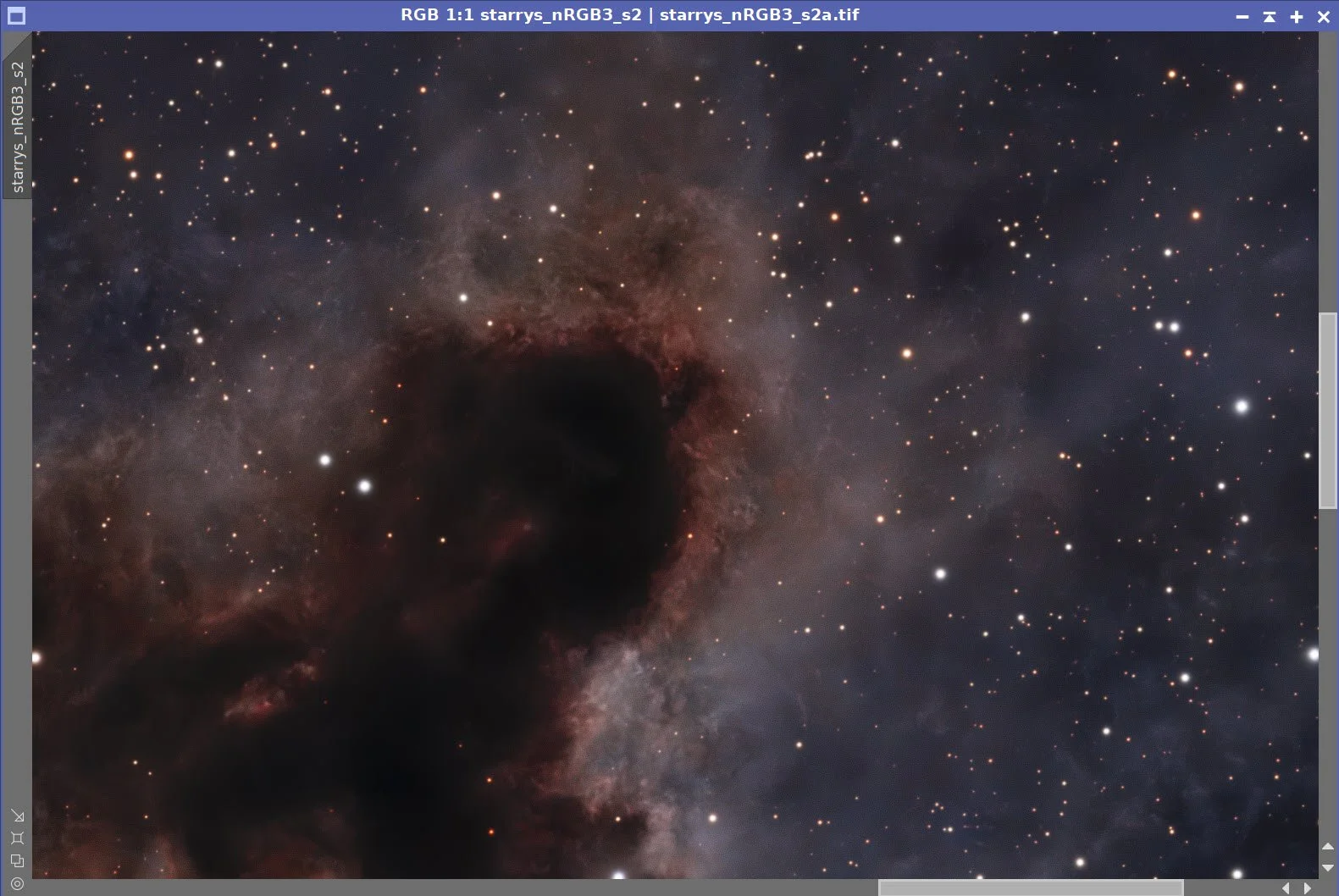
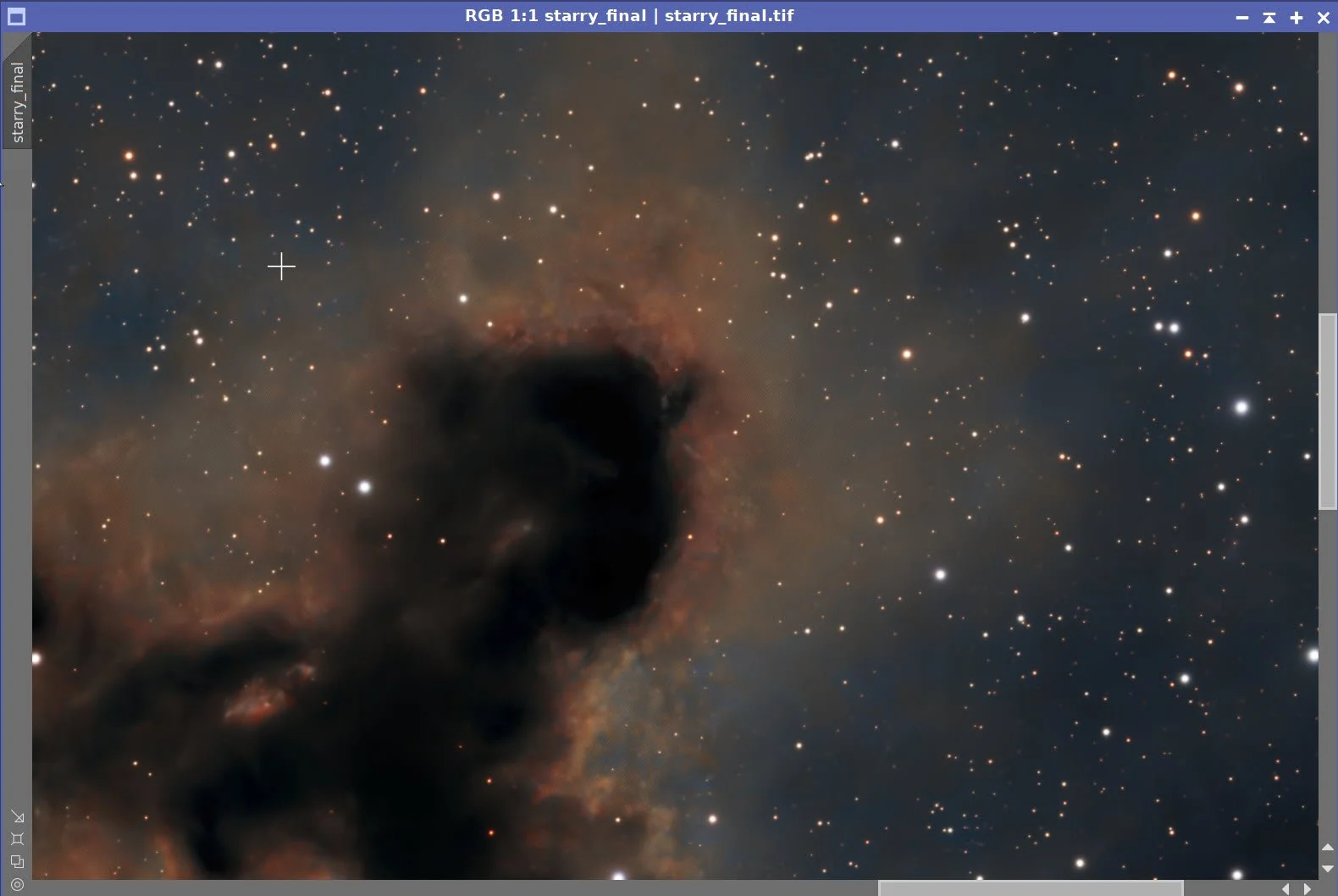
Original vs Final Noise Artifact Comparison
So I tried backing off on the NR I was doing, and I ended up with a high-frequency Stipple pattern across the image that I did not like any better than the too-smooth results.
At the end of the day, I went with the “too smooth” image.
I am really unhappy with it and my efforts here. I am not proud at all of this image. But I have pounded my head against the wall so much on this one that my head was getting lumpy, and I was ready to move on due to simple mental exhaustion on this image.
So, if I am not happy with it, why publish it?
A long time back, I decided I was not going to censor my bad results. There is something to learn from such efforts. Even if that is the only learning, it is that not all projects work out the way you would like…
Final Take-Away
The final image is OK, but not great. It still presents a very interesting target, but I was somewhat disappointed with my results.
I can blame this on noise and the challenges of dealing with dark nebulae, but at the end of the day to the reason this did not come out right is because of a fundamental mistake that I made.
I decided to shoot this target on my AP130 telescope. This scope has beautiful optics, and some of my best images have been taken with it. I still needed a target for this scope for the last imaging cycle, and I ended up assigning the Seahorse to it.
Fundamentally a bad move!
This is a slow scope. It is f/8.35. And this is what really did me in.
I was not thinking analytically when I chose this scope for this target.
So let's do a little thought experiment:
Let's assume I shot this with an f/5.5 scope with an exposure time of 18 hours.
(That’s a likely scenario, as 2 of my scopes are f/5.5 and another is f/5.)
What if I were to change to the AP130 and its f/8.35 optics?
How much more integration time would I need to get the same exposure as 18 hours on the f/5.5 system?
Wow! I would have had to increase my integration time by 2.3X!
Now I really wish that I had chosen a different scope!
It does well with brighter objects, but is a poor choice for dark nebulae!
Duh. Live and learn. I guess. :-)
Detailed and Annotated image Processing Walkthrough
Typical, I end one of these imaging projects with a docuemntation of the processing steps I used on this image. But I have that this section can be quite large and cause the page to load more slowly. Starting with this project, I am creating a secondary, stand alone page to hold this information. Yo can get to this page by selecting the link below. Returning back to this page is as simple as hitting the back arrow on your browser. I hope you like this new format.
Hit the Link below to see the detailed image processing walkthrough page for this Imaging Project!
Barnard 150 - The Seahorse Nebula - Image Processing Walkthrough
More Information
🔭 Target Details:
NASA APOD – Barnard 150: Seahorse in Cepheus (2018-10-25) – Overview image and description of the Seahorse Nebula (Barnard 150) silhouetted against a rich star field in Cepheus.
SIMBAD – Barnard 150 – Database entry with coordinates, identifiers, and basic object data (dark nebula in Cepheus).
Wikimedia Commons – Seahorse Nebula – Library of freely usable images of Barnard 150 for outreach and educational purposes.
📜 History & Naming:
Barnard 1919, ApJ 49, 1 – “On the Dark Markings of the Sky” (ADS) – The first systematic catalog of dark nebulae; lists this object as Barnard 150 with notes on its curved, ~1° long appearance in Cepheus.
Lynds 1962, ApJS 7, 1 – “Catalogue of Dark Nebulae” (ADS) – Establishes the LDN designations and includes Barnard 150 as LDN 1082 with position and opacity information.
Barnard Catalogue – Wikipedia – Concise overview of E. E. Barnard’s dark-nebula catalog, providing historical context and references for the nomenclature still used today.
🔬 Science & Observations:
Furuya et al. 2006, ApJ 653, 1369 (ADS) – Detailed study of the GF 9-2/L1082C core in B150 identifies an extremely young Class 0 protostar and infall motions, characterizing the earliest collapse stage with no large-scale outflow yet.
Clemens et al. 2018, ApJ 867, 79 (arXiv) – SOFIA/HAWC+ and near-IR polarimetry show a remarkably uniform magnetic field from ~3 pc down to ~6000 AU across GF 9/L1082C, with a distance estimate of ~270 pc; results challenge weak-field collapse models.
Furuya, Kitamura & Shinnaga 2008 (arXiv) – NH₃ mapping of the GF 9 (LDN 1082) filament reveals at least seven cold, dense cores separated by ~0.9 pc, consistent with gravitational fragmentation in a low-mass star-forming filament.
Kirk et al. 2009, ApJS 185, 198 (ADS) – Spitzer Gould Belt survey of the Cepheus Flare region (includes LDN 1082/B150) catalogs YSOs and provides infrared context for ongoing low-mass star formation.
Kun et al. 2008 – Star-Forming Regions in Cepheus (arXiv) – Review of Cepheus star-forming clouds summarizes the L 1082/B150 (GF 9) filament, its dense cores (A/B/C), and evidence for ongoing star formation within the complex.
💡 Interesting Facts & Outreach:
AstroBin – Barnard 150 “Seahorse Nebula” – High-resolution amateur image of the Seahorse Nebula with acquisition details. The dark, twisting dust cloud is seen in stark relief against the starry background. This community-contributed image provides a visual reference for the nebula’s appearance and scale (about 1° long, or two full Moons across) in the night sky .
Seahorse Nebula – Constellation Guide – An outreach article covering Barnard 150’s identity as the “Dark Seahorse” in Cepheus. Provides background on its catalog names (B150, LDN 1082) and physical nature (cold molecular dust cloud), as well as observing tips. Describes how the nebula’s three dense cores (L1082 A, B, C) are active star-forming regions, and notes the nebula’s position halfway between the Flying Bat Nebula (Sh 2-129) and the Fireworks Galaxy (NGC 6946) in the sky.
Capture Details
Lights Frames
Taken the nights of August 22, 24, 30, and 31, 2025
294 x 90 seconds, bin 1x1 @ -10C, Gain 0, ZWO Lum - 36mm unmounted
145 x 90 seconds, bin 1x1 @ -10C, Gain 0, ZWO Red - 36mm unmounted
146 x 90 seconds, bin 1x1 @ -10C, Gain 0, ZWO Green - 36mm unmounted
148 x 90 seconds, bin 1x1 @ -10C, Gain 0, ZWO Blue - 36mm unmounted
Total - after culling bad subs - of 18 hours 22.5 minutes.
Cal Frames
30 Darks at 90 seconds, bin 1x1, -10C, gain 0
30 Dark Flats at Flat exposure times, bin 1x1, -10C, gain 0
One set of Flats done:
15 Lum Flats
15 R Flats
15 G Flats
15 B Flats
Capture Hardware
Scope: Astro-Physics 130mm F/8.35 Starfire APO built in 2003
Guide Scope: Tele Vue TV76 F/6.3 480mm APO Doublet
Main Focuser: Pegasus Astro Focus Cube 2
Guide Focuser: Pegasus Astro Focus Cube 2
Mount: Custom Steel Pier - New
Main Camera: ZWO ASI2600MM-Pro
Filter Wheel: ZWO EFW 7x36
Filters: ZWO 36mm unmounted Gen II LRGB filters
Astronomiks 36mm unmounted 6nm Ha, OIII, & SII filters
Rotator: Pegasus Astro Falcon Camera Rotator
Guide Camera: ZWO ASI290MM-Mini
Power Dist: Pegasus Astro Pocket Powerbox
USB Dist: Hub: Startech 7-slot USB 3.0 Hub
Computer: Mele Quieter 4C Microcomputer running Win 11
Software
Capture Software: PHD2 Guider, NINA
Image Processing: Pixinsight, Photoshop - assisted by Coffee, extensive processing indecision and second-guessing, editor regret, and much swearing…..


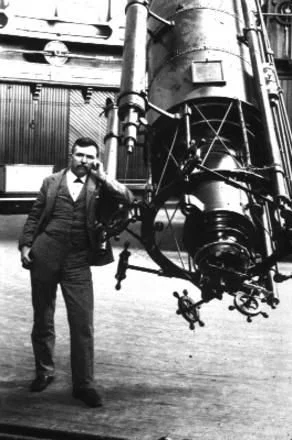
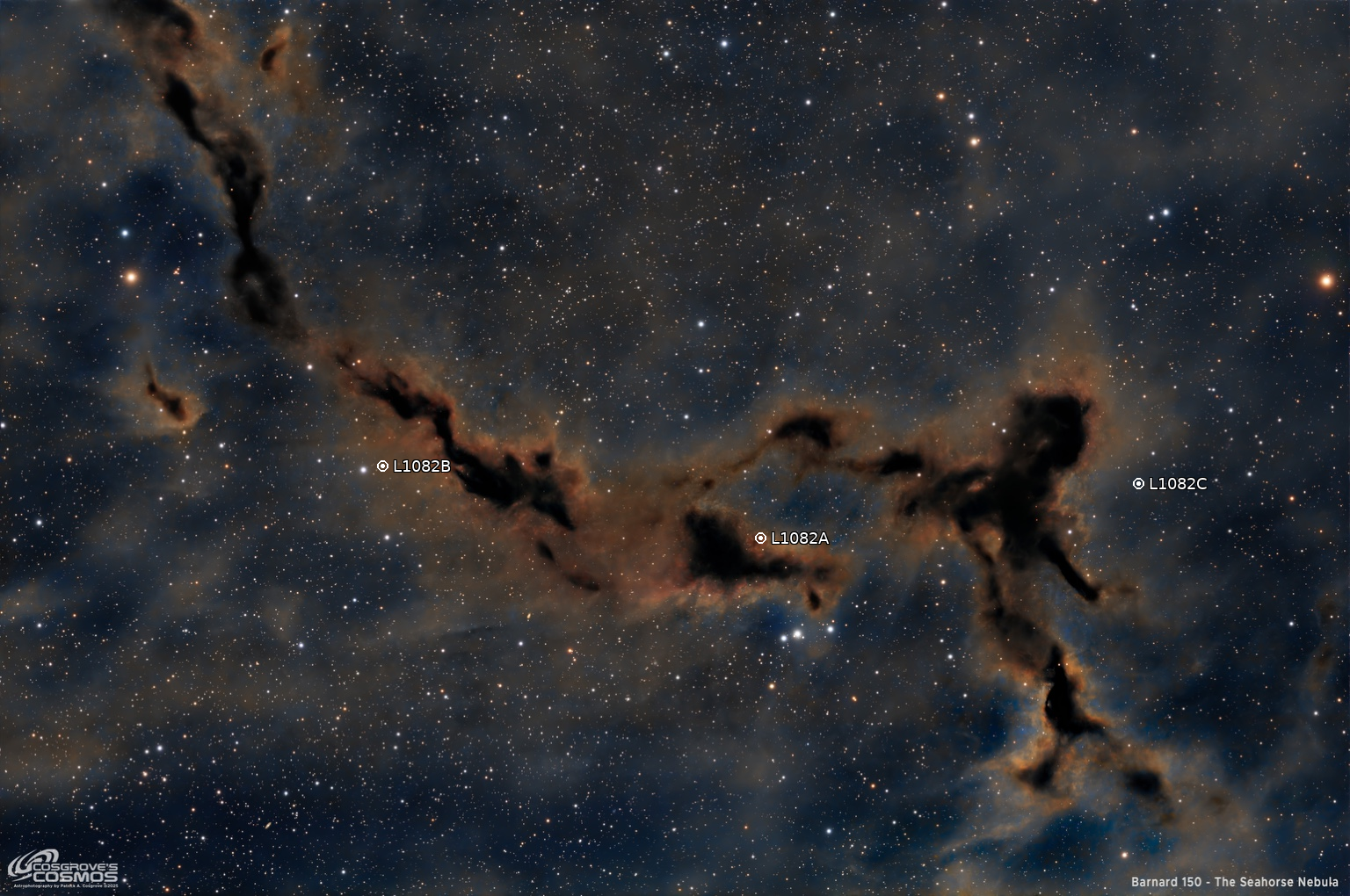
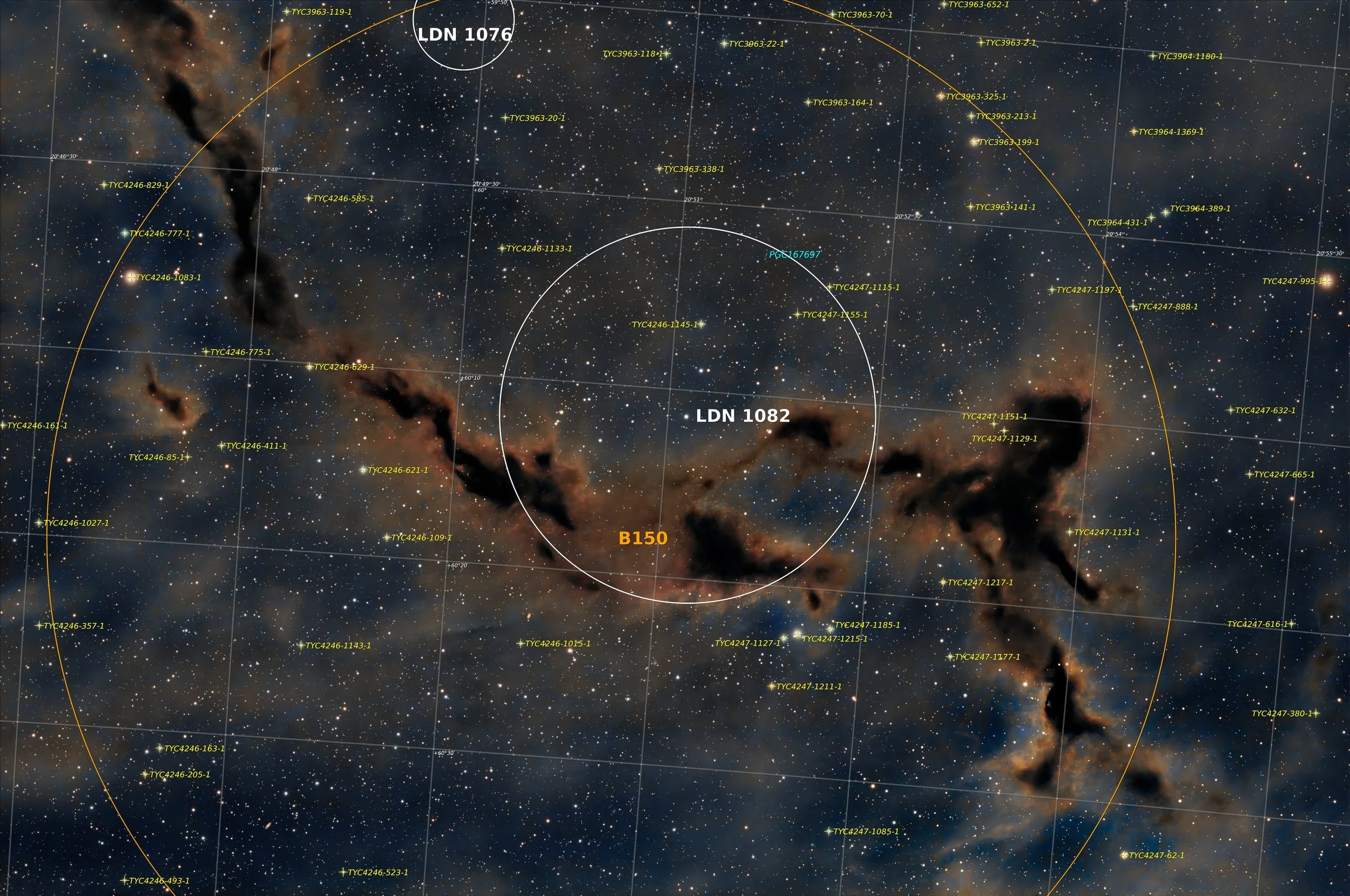
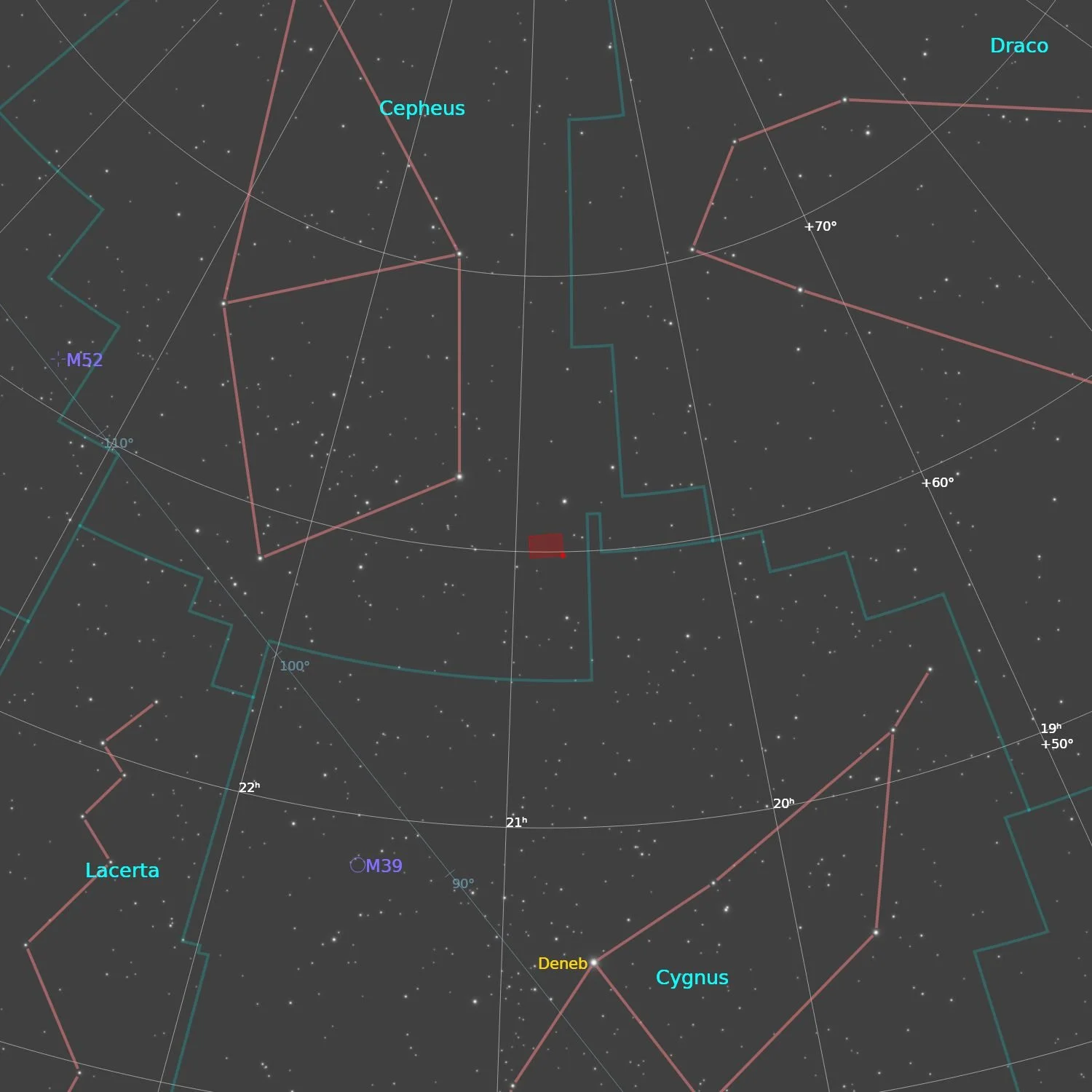
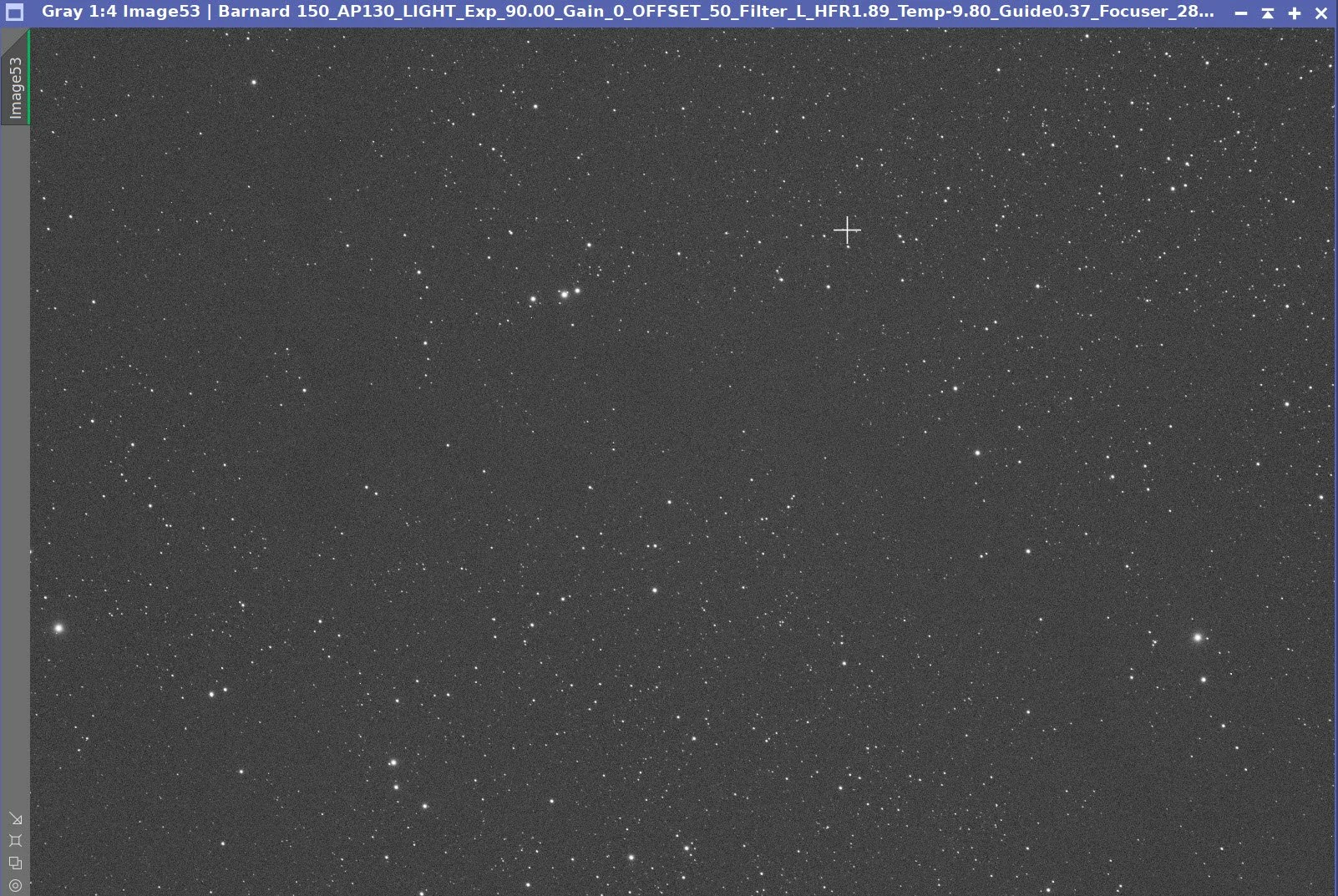
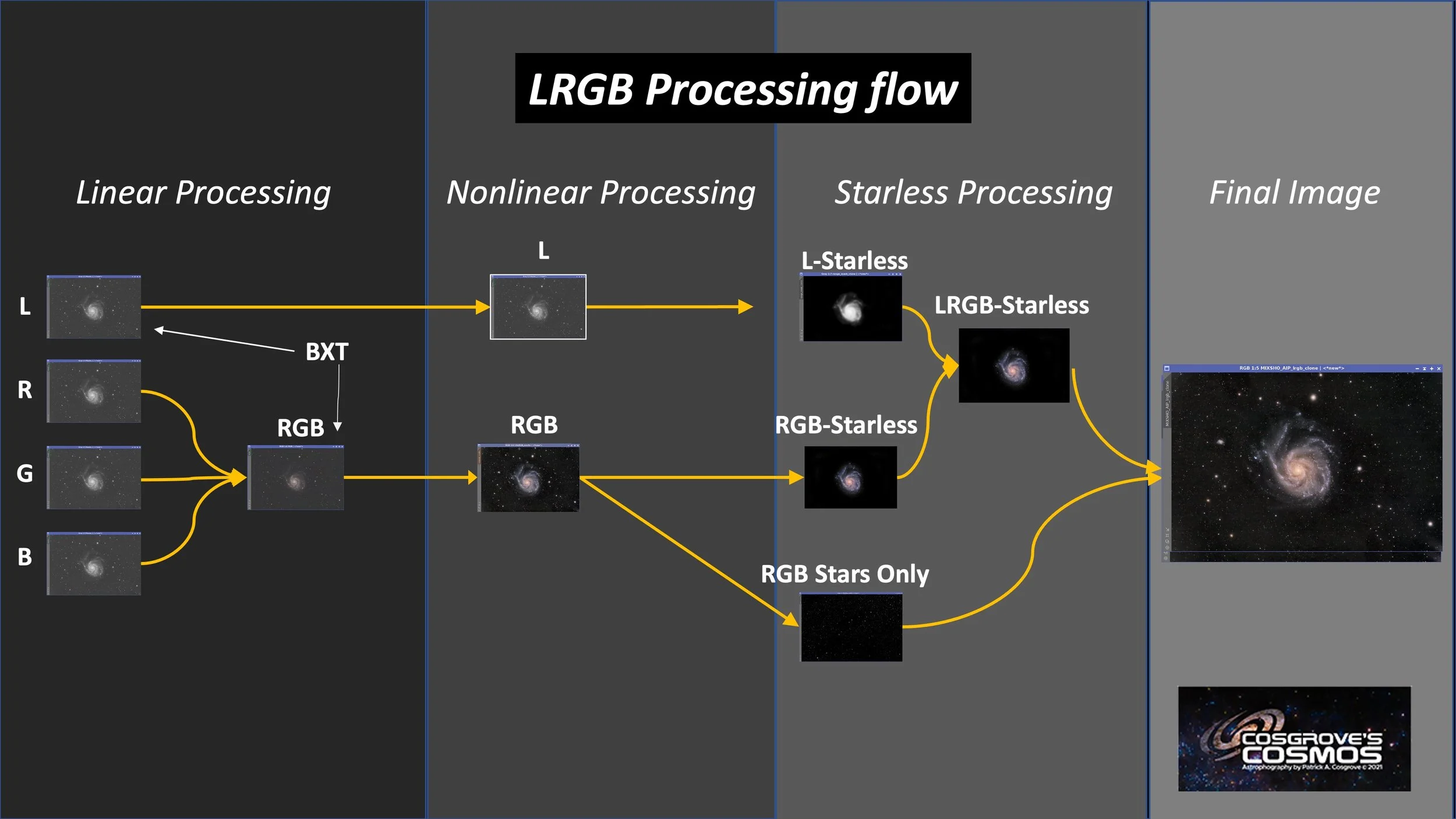
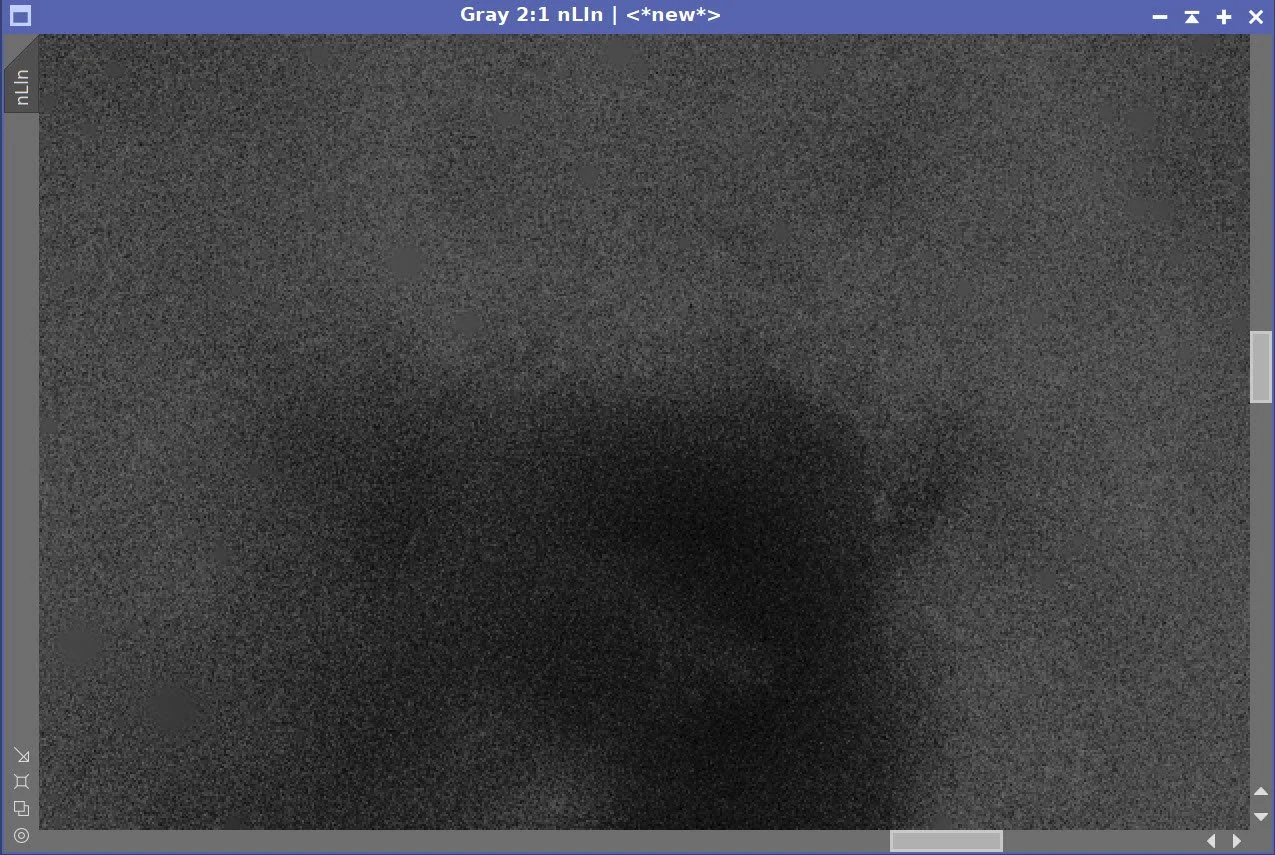

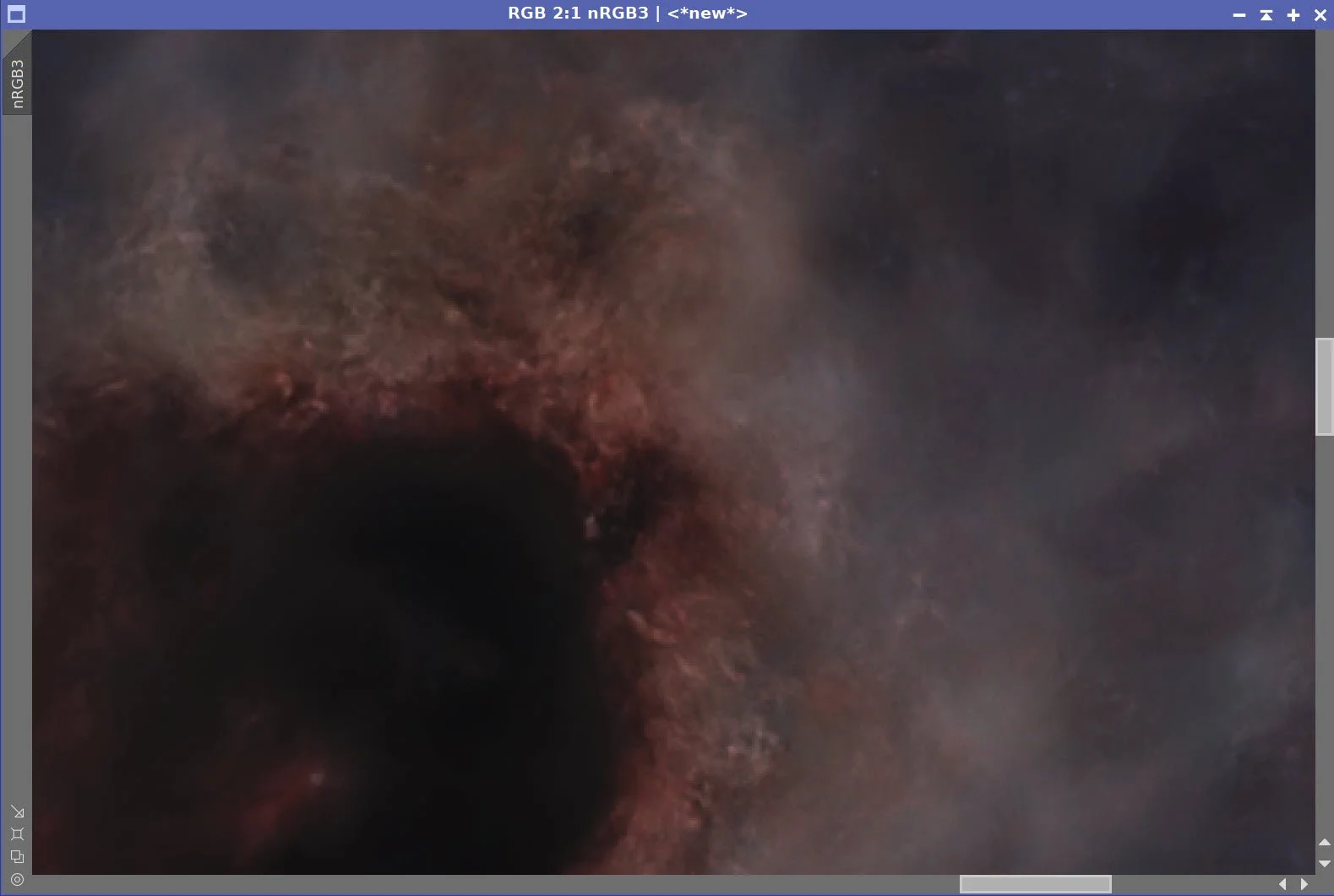

Moving the platform to the Whispering Skies Observatory means shifting to a new steel pier and a new computer!